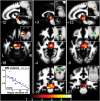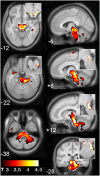A brain MRI study of chronic fatigue syndrome: evidence of brainstem dysfunction and altered homeostasis
- PMID: 21560176
- PMCID: PMC4369126
- DOI: 10.1002/nbm.1692
A brain MRI study of chronic fatigue syndrome: evidence of brainstem dysfunction and altered homeostasis
Abstract
To explore brain involvement in chronic fatigue syndrome (CFS), the statistical parametric mapping of brain MR images has been extended to voxel-based regressions against clinical scores. Using SPM5 we performed voxel-based morphometry (VBM) and analysed T(1) - and T(2) -weighted spin-echo MR signal levels in 25 CFS subjects and 25 normal controls (NC). Clinical scores included CFS fatigue duration, a score based on the 10 most common CFS symptoms, the Bell score, the hospital anxiety and depression scale (HADS) anxiety and depression, and hemodynamic parameters from 24-h blood pressure monitoring. We also performed group × hemodynamic score interaction regressions to detect locations where MR regressions were opposite for CFS and NC, thereby indicating abnormality in the CFS group. In the midbrain, white matter volume was observed to decrease with increasing fatigue duration. For T(1) -weighted MR and white matter volume, group × hemodynamic score interactions were detected in the brainstem [strongest in midbrain grey matter (GM)], deep prefrontal white matter (WM), the caudal basal pons and hypothalamus. A strong correlation in CFS between brainstem GM volume and pulse pressure suggested impaired cerebrovascular autoregulation. It can be argued that at least some of these changes could arise from astrocyte dysfunction. These results are consistent with an insult to the midbrain at fatigue onset that affects multiple feedback control loops to suppress cerebral motor and cognitive activity and disrupt local CNS homeostasis, including resetting of some elements of the autonomic nervous system (ANS).
Copyright © 2011 John Wiley & Sons, Ltd.
Figures





References
-
- Fukuda K, Straus SE, Hickie I, Sharpe MC, Dobbins JG, Komaroff A. The chronic fatigue syndrome: a comprehensive approach to its definition and study. Ann. Intern. Med. 1994;121:953–959. - PubMed
-
- Michiels V, Cluydts R. Neuropsychological functioning in chronic fatigue syndrome: a review. Acta Psychiatr. Scand. 2001;103:84–93. - PubMed
-
- de Lange F, Kalkman J, Bleijenberg G, Hagoort P, Sieberen P, van der Werf S, et al. Neural correlates of the chronic fatigue syndrome - an fMRI study. Brain. 2004;127:1948–1957. - PubMed
-
- Newton J, Okonkwo O, Sutcliffe K, Seth A, Shin J, Jones D. Symptoms of autonomic dysfunction in chronic fatigue syndrome. Q. J. Med. 2007;100:519–526. - PubMed
Publication types
MeSH terms
LinkOut - more resources
Full Text Sources
Medical

